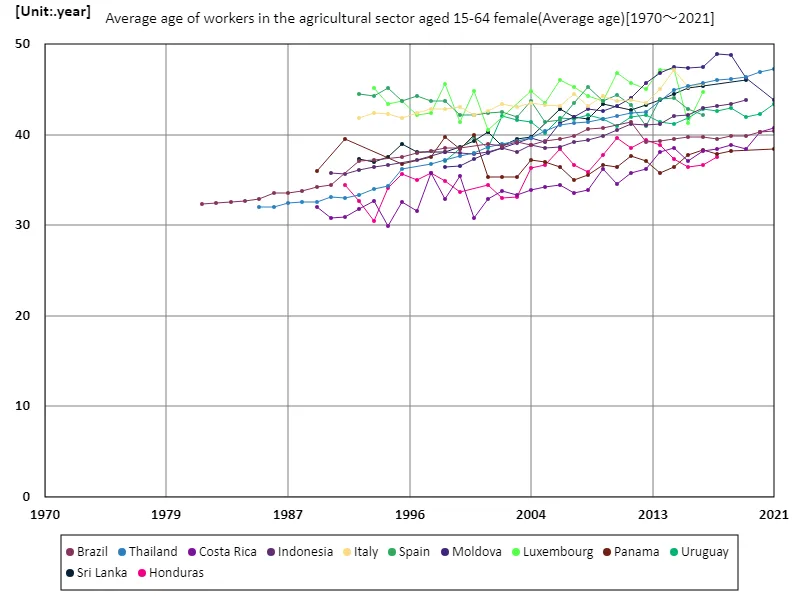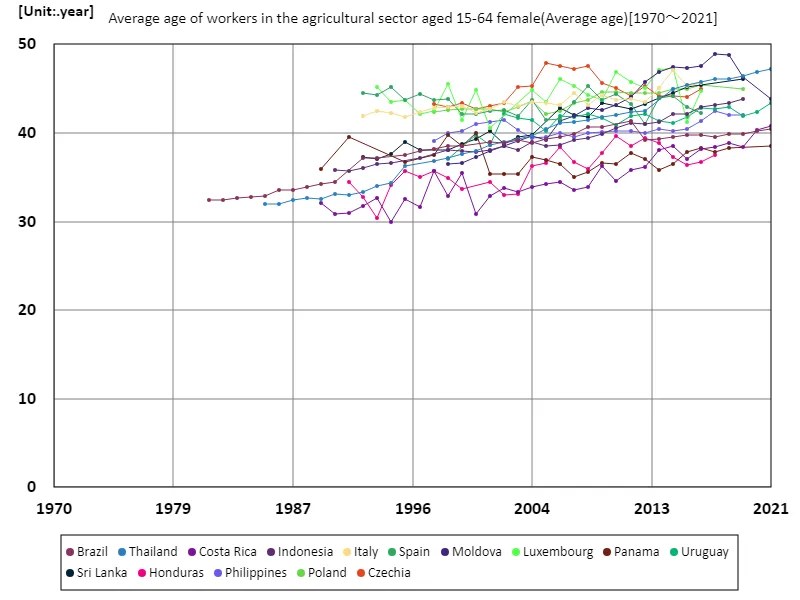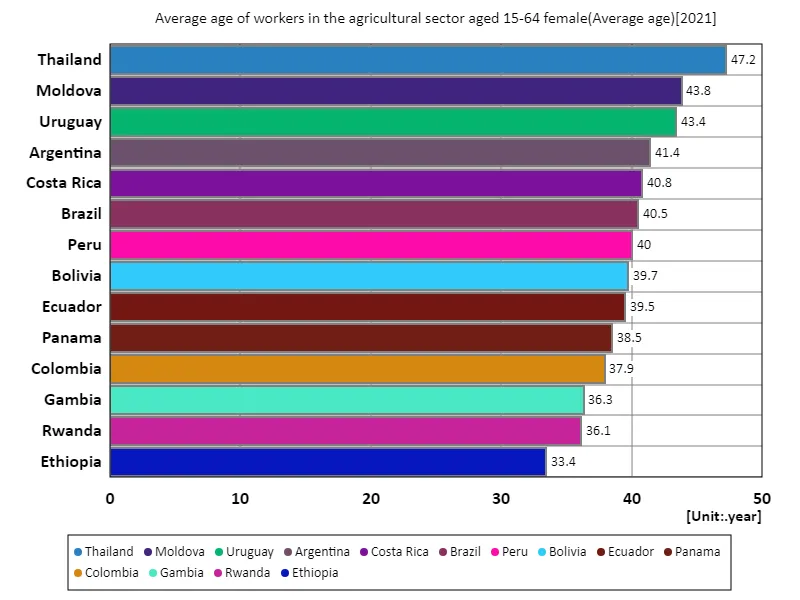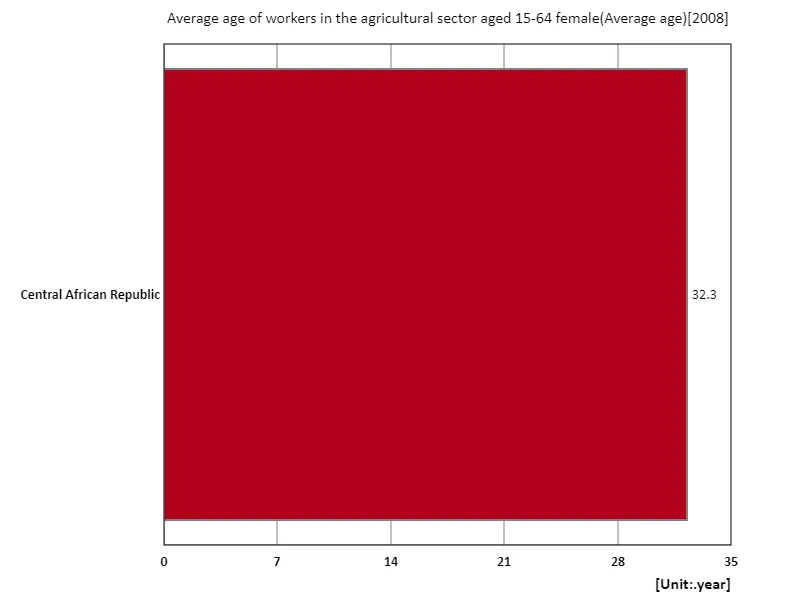- Abstract
- Agriculture sector, female workers aged 15-64, average age
- Agriculture sector, female workers aged 15-64, average age (worldwide)
- Agriculture sector, female workers aged 15-64, average age (world, latest year)
- Agriculture sector, female workers aged 15-64, average age (region, latest year)
- Reference
Abstract
The trend towards a higher average age for female workers in the agricultural sector (15-64 years old) can be explained by several factors. The reason why Thailand recorded its highest age at 47.2 years in 2021 is due to the aging population in the agricultural sector. In general, agriculture has less influx of young people than other industries, which is due to population migration to urban areas and changes in the industrial structure. Urbanization and technological change are driving many young people away from agriculture, while those who remain are getting older. Older workers often make up the bulk of the workforce, especially in countries like Thailand where agriculture remains an important economic sector. This trend suggests the need for policies aimed at retaining the agricultural workforce and improving agricultural productivity. Additionally, technological innovation and efforts to encourage young people to return to agriculture will likely be important issues going forward.
Agriculture sector, female workers aged 15-64, average age
From 1981 to 2021, the average age of female workers aged 15-64 in the agricultural sector shows a notable ageing trend. In particular, in 2017, Moldova recorded the highest median age at 48.9 years. The background to this ageing population includes the harsh conditions of farming, low wages, and population migration to cities. In the case of Moldova, there has been an 89.6% age decline from the peak, which represents a sign of progress in tackling the ageing process, but the agricultural sector continues to have an older workforce. Compared to other industries, the agricultural sector is prone to aging because the turnover of workers is slower and there is less inflow of young people. In particular, in Eastern European and Central Asian countries, the harsh agricultural conditions and low income levels are accelerating the decline of young people from agriculture, leaving many older workers behind. Another factor is that as agriculture becomes more mechanized and efficient, older workers are slower to acquire new skills. To combat this ageing trend, measures to increase the attractiveness of the agricultural sector, improve technical education for young people, and improve working conditions are needed. This will enable sustainable agriculture and regenerate the workforce.


The maximum is 48.9year[2017] of Moldova, and the current value is about 89.6%
Agriculture sector, female workers aged 15-64, average age (worldwide)
Between 1981 and 2021, the average age of female workers aged 15-64 in the agricultural sector has increased significantly. In particular, Moldova recorded its highest average age of 48.9 years in 2017, and although the population has continued to age since then, it has now fallen to 89.6% of the peak. This reflects the growing ageing of the agricultural sector and changes in the workforce in recent years. As can be seen from the case of Moldova, there is little inflow of young people into the agricultural sector, and the number of older workers tends to increase as migration from rural to urban areas progresses. Due to harsh conditions such as long working hours and low wages, agriculture is no longer an attractive career option for young people. Another factor is the difficulty older workers face in adapting to new technologies as agriculture becomes more mechanized and more technologically advanced. In Moldova, the decline in average age from the peak suggests that the agricultural sector may be undergoing reform and labor force replenishment. For example, it appears that progress is being made with young people returning to agriculture, the efficient use of labor, and the introduction of agricultural technology. Overall, however, the ageing population in the agricultural sector remains a significant challenge, and further efforts to improve working conditions and attract younger generations are needed to ensure sustainable agriculture.


The maximum is 48.9year[2017] of Moldova, and the current value is about 89.6%
Agriculture sector, female workers aged 15-64, average age (world, latest year)
According to 2021 data, the average age of female workers aged 15-64 in the agricultural sector is 39.9 years, with Thailand recording the highest age at 47.2 years. This indicates that the agricultural sector is aging faster than other industries. The proportion of older workers tends to be particularly high in countries where agriculture is the main industry, such as Thailand. Thailand’s figure of 47.2 years indicates a significant aging population in the agricultural sector, which is thought to be due to the low influx of young people into agriculture and the harsh working conditions in the industry. As can be seen from the overall average age of 39.9 years, workers in the agricultural sector are older than workers in other industries, reflecting their tendency to stay in the same industry for longer periods of time. Furthermore, the ageing workforce in the agricultural sector is driven by population migration to urban areas and industrial diversification. In order to alleviate the aging of the workforce, it is necessary to encourage young people to enter agriculture, innovate agricultural technology, and improve working conditions. This is expected to establish sustainable agriculture and promote generational change.


The maximum is 47.2year of Thailand, the average is 39.9year, and the total is 559year
Agriculture sector, female workers aged 15-64, average age (region, latest year)
According to 2008 data, the average age of female workers aged 15-64 in the agricultural sector was 32.3 years, with the Central African Republic recording the highest figure. This figure reflects the relatively young age of the agricultural workforce and reflects specific regional characteristics and trends. In many developing countries, including the Central African Republic, agriculture is the primary source of livelihood and the rural workforce is largely made up of a relatively young workforce. This is because while urbanization is progressing, young people in rural areas are still engaged in agriculture. Additionally, in these areas, young people are more likely to remain in agriculture as it is their main source of livelihood. The average age of 32.3 years reflects a relatively young agricultural workforce in developing countries, but at the same time, this age group is at risk of ageing. Given the outflow of young people and the aging of the population, technological innovation and improvements in working conditions are essential to ensure the sustainability of the agricultural sector. This is expected to ensure a more stable labour supply in the future and support the development of the agricultural sector.


The maximum is 32.3year of Central African Republic, the average is 32.3year, and the total is 32.3year



Comments